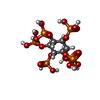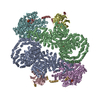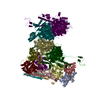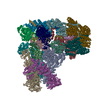[English] 日本語
 Yorodumi
Yorodumi- EMDB-13347: cryo-EM structure of DEPTOR bound to human mTOR complex 2, overal... -
+ Open data
Open data
- Basic information
Basic information
| Entry | Database: EMDB / ID: EMD-13347 | |||||||||
|---|---|---|---|---|---|---|---|---|---|---|
| Title | cryo-EM structure of DEPTOR bound to human mTOR complex 2, overall refinement | |||||||||
 Map data Map data | ||||||||||
 Sample Sample |
| |||||||||
| Function / homology |  Function and homology information Function and homology informationnegative regulation of TORC2 signaling / regulation of extrinsic apoptotic signaling pathway / TORC2 signaling / regulation of peptidyl-serine phosphorylation / RNA polymerase III type 2 promoter sequence-specific DNA binding / positive regulation of cytoplasmic translational initiation / RNA polymerase III type 1 promoter sequence-specific DNA binding / positive regulation of pentose-phosphate shunt / T-helper 1 cell lineage commitment / regulation of locomotor rhythm ...negative regulation of TORC2 signaling / regulation of extrinsic apoptotic signaling pathway / TORC2 signaling / regulation of peptidyl-serine phosphorylation / RNA polymerase III type 2 promoter sequence-specific DNA binding / positive regulation of cytoplasmic translational initiation / RNA polymerase III type 1 promoter sequence-specific DNA binding / positive regulation of pentose-phosphate shunt / T-helper 1 cell lineage commitment / regulation of locomotor rhythm / positive regulation of wound healing, spreading of epidermal cells / cellular response to leucine starvation / TFIIIC-class transcription factor complex binding /  TORC2 complex / heart valve morphogenesis / TORC2 complex / heart valve morphogenesis /  regulation of membrane permeability / negative regulation of lysosome organization / RNA polymerase III type 3 promoter sequence-specific DNA binding / regulation of membrane permeability / negative regulation of lysosome organization / RNA polymerase III type 3 promoter sequence-specific DNA binding /  TORC1 complex / positive regulation of transcription of nucleolar large rRNA by RNA polymerase I / calcineurin-NFAT signaling cascade / regulation of cellular response to oxidative stress / TORC1 complex / positive regulation of transcription of nucleolar large rRNA by RNA polymerase I / calcineurin-NFAT signaling cascade / regulation of cellular response to oxidative stress /  regulation of autophagosome assembly / TORC1 signaling / voluntary musculoskeletal movement / regulation of osteoclast differentiation / positive regulation of keratinocyte migration / cellular response to L-leucine / MTOR signalling / Amino acids regulate mTORC1 / cellular response to nutrient / energy reserve metabolic process / Energy dependent regulation of mTOR by LKB1-AMPK / regulation of autophagosome assembly / TORC1 signaling / voluntary musculoskeletal movement / regulation of osteoclast differentiation / positive regulation of keratinocyte migration / cellular response to L-leucine / MTOR signalling / Amino acids regulate mTORC1 / cellular response to nutrient / energy reserve metabolic process / Energy dependent regulation of mTOR by LKB1-AMPK /  phosphatidic acid binding / nucleus localization / negative regulation of Ras protein signal transduction / negative regulation of TOR signaling / ruffle organization / protein serine/threonine kinase inhibitor activity / negative regulation of cell size / cellular response to osmotic stress / phosphatidylinositol-3,4-bisphosphate binding / phosphatidylinositol-3,5-bisphosphate binding / regulation of establishment of cell polarity / phosphatidic acid binding / nucleus localization / negative regulation of Ras protein signal transduction / negative regulation of TOR signaling / ruffle organization / protein serine/threonine kinase inhibitor activity / negative regulation of cell size / cellular response to osmotic stress / phosphatidylinositol-3,4-bisphosphate binding / phosphatidylinositol-3,5-bisphosphate binding / regulation of establishment of cell polarity /  anoikis / cardiac muscle cell development / positive regulation of transcription by RNA polymerase III / negative regulation of protein localization to nucleus / embryo development ending in birth or egg hatching / anoikis / cardiac muscle cell development / positive regulation of transcription by RNA polymerase III / negative regulation of protein localization to nucleus / embryo development ending in birth or egg hatching /  regulation of myelination / negative regulation of calcineurin-NFAT signaling cascade / regulation of myelination / negative regulation of calcineurin-NFAT signaling cascade /  Macroautophagy / Macroautophagy /  regulation of cell size / negative regulation of macroautophagy / lysosome organization / positive regulation of oligodendrocyte differentiation / positive regulation of actin filament polymerization / regulation of cell size / negative regulation of macroautophagy / lysosome organization / positive regulation of oligodendrocyte differentiation / positive regulation of actin filament polymerization /  protein kinase inhibitor activity / positive regulation of myotube differentiation / behavioral response to pain / regulation of phosphatidylinositol 3-kinase/protein kinase B signal transduction / protein kinase inhibitor activity / positive regulation of myotube differentiation / behavioral response to pain / regulation of phosphatidylinositol 3-kinase/protein kinase B signal transduction /  TOR signaling / oligodendrocyte differentiation / mTORC1-mediated signalling / germ cell development / Constitutive Signaling by AKT1 E17K in Cancer / phosphatidylinositol-3,4,5-trisphosphate binding / cellular response to nutrient levels / CD28 dependent PI3K/Akt signaling / positive regulation of phosphoprotein phosphatase activity / positive regulation of translational initiation / neuronal action potential / HSF1-dependent transactivation / positive regulation of TOR signaling / positive regulation of epithelial to mesenchymal transition / TOR signaling / oligodendrocyte differentiation / mTORC1-mediated signalling / germ cell development / Constitutive Signaling by AKT1 E17K in Cancer / phosphatidylinositol-3,4,5-trisphosphate binding / cellular response to nutrient levels / CD28 dependent PI3K/Akt signaling / positive regulation of phosphoprotein phosphatase activity / positive regulation of translational initiation / neuronal action potential / HSF1-dependent transactivation / positive regulation of TOR signaling / positive regulation of epithelial to mesenchymal transition /  regulation of macroautophagy / regulation of macroautophagy /  endomembrane system / 'de novo' pyrimidine nucleobase biosynthetic process / response to amino acid / positive regulation of lipid biosynthetic process / phagocytic vesicle / positive regulation of lamellipodium assembly / positive regulation of autophagy / heart morphogenesis / regulation of cellular response to heat / cytoskeleton organization / cardiac muscle contraction / negative regulation of TORC1 signaling / positive regulation of stress fiber assembly / endomembrane system / 'de novo' pyrimidine nucleobase biosynthetic process / response to amino acid / positive regulation of lipid biosynthetic process / phagocytic vesicle / positive regulation of lamellipodium assembly / positive regulation of autophagy / heart morphogenesis / regulation of cellular response to heat / cytoskeleton organization / cardiac muscle contraction / negative regulation of TORC1 signaling / positive regulation of stress fiber assembly /  phosphatidylinositol-4,5-bisphosphate binding / cellular response to amino acid starvation / T cell costimulation / substantia nigra development / cellular response to starvation / positive regulation of endothelial cell proliferation / positive regulation of glycolytic process / protein serine/threonine kinase activator activity / response to nutrient levels / post-embryonic development / response to nutrient phosphatidylinositol-4,5-bisphosphate binding / cellular response to amino acid starvation / T cell costimulation / substantia nigra development / cellular response to starvation / positive regulation of endothelial cell proliferation / positive regulation of glycolytic process / protein serine/threonine kinase activator activity / response to nutrient levels / post-embryonic development / response to nutrientSimilarity search - Function | |||||||||
| Biological species |   Homo sapiens (human) Homo sapiens (human) | |||||||||
| Method |  single particle reconstruction / single particle reconstruction /  cryo EM / Resolution: 3.41 Å cryo EM / Resolution: 3.41 Å | |||||||||
 Authors Authors | Waelchli M / Maier T | |||||||||
| Funding support |  Switzerland, 1 items Switzerland, 1 items
| |||||||||
 Citation Citation |  Journal: Elife / Year: 2021 Journal: Elife / Year: 2021Title: Regulation of human mTOR complexes by DEPTOR. Authors: Matthias Wälchli / Karolin Berneiser / Francesca Mangia / Stefan Imseng / Louise-Marie Craigie / Edward Stuttfeld / Michael N Hall / Timm Maier /  Abstract: The vertebrate-specific DEP domain-containing mTOR interacting protein (DEPTOR), an oncoprotein or tumor suppressor, has important roles in metabolism, immunity, and cancer. It is the only protein ...The vertebrate-specific DEP domain-containing mTOR interacting protein (DEPTOR), an oncoprotein or tumor suppressor, has important roles in metabolism, immunity, and cancer. It is the only protein that binds and regulates both complexes of mammalian target of rapamycin (mTOR), a central regulator of cell growth. Biochemical analysis and cryo-EM reconstructions of DEPTOR bound to human mTOR complex 1 (mTORC1) and mTORC2 reveal that both structured regions of DEPTOR, the PDZ domain and the DEP domain tandem (DEPt), are involved in mTOR interaction. The PDZ domain binds tightly with mildly activating effect, but then acts as an anchor for DEPt association that allosterically suppresses mTOR activation. The binding interfaces of the PDZ domain and DEPt also support further regulation by other signaling pathways. A separate, substrate-like mode of interaction for DEPTOR phosphorylation by mTOR complexes rationalizes inhibition of non-stimulated mTOR activity at higher DEPTOR concentrations. The multifaceted interplay between DEPTOR and mTOR provides a basis for understanding the divergent roles of DEPTOR in physiology and opens new routes for targeting the mTOR-DEPTOR interaction in disease. | |||||||||
| History |
|
- Structure visualization
Structure visualization
| Movie |
 Movie viewer Movie viewer |
|---|---|
| Structure viewer | EM map:  SurfView SurfView Molmil Molmil Jmol/JSmol Jmol/JSmol |
| Supplemental images |
- Downloads & links
Downloads & links
-EMDB archive
| Map data |  emd_13347.map.gz emd_13347.map.gz | 398.3 MB |  EMDB map data format EMDB map data format | |
|---|---|---|---|---|
| Header (meta data) |  emd-13347-v30.xml emd-13347-v30.xml emd-13347.xml emd-13347.xml | 22.5 KB 22.5 KB | Display Display |  EMDB header EMDB header |
| Images |  emd_13347.png emd_13347.png | 132.9 KB | ||
| Masks |  emd_13347_msk_1.map emd_13347_msk_1.map | 421.9 MB |  Mask map Mask map | |
| Archive directory |  http://ftp.pdbj.org/pub/emdb/structures/EMD-13347 http://ftp.pdbj.org/pub/emdb/structures/EMD-13347 ftp://ftp.pdbj.org/pub/emdb/structures/EMD-13347 ftp://ftp.pdbj.org/pub/emdb/structures/EMD-13347 | HTTPS FTP |
-Related structure data
| Related structure data |  7pe7MC  7pe8C  7pe9C  7peaC  7pebC  7pecC  7pedC M: atomic model generated by this map C: citing same article ( |
|---|---|
| Similar structure data |
- Links
Links
| EMDB pages |  EMDB (EBI/PDBe) / EMDB (EBI/PDBe) /  EMDataResource EMDataResource |
|---|---|
| Related items in Molecule of the Month |
- Map
Map
| File |  Download / File: emd_13347.map.gz / Format: CCP4 / Size: 421.9 MB / Type: IMAGE STORED AS FLOATING POINT NUMBER (4 BYTES) Download / File: emd_13347.map.gz / Format: CCP4 / Size: 421.9 MB / Type: IMAGE STORED AS FLOATING POINT NUMBER (4 BYTES) | ||||||||||||||||||||||||||||||||||||||||||||||||||||||||||||||||||||
|---|---|---|---|---|---|---|---|---|---|---|---|---|---|---|---|---|---|---|---|---|---|---|---|---|---|---|---|---|---|---|---|---|---|---|---|---|---|---|---|---|---|---|---|---|---|---|---|---|---|---|---|---|---|---|---|---|---|---|---|---|---|---|---|---|---|---|---|---|---|
| Voxel size | X=Y=Z: 1.058 Å | ||||||||||||||||||||||||||||||||||||||||||||||||||||||||||||||||||||
| Density |
| ||||||||||||||||||||||||||||||||||||||||||||||||||||||||||||||||||||
| Symmetry | Space group: 1 | ||||||||||||||||||||||||||||||||||||||||||||||||||||||||||||||||||||
| Details | EMDB XML:
CCP4 map header:
| ||||||||||||||||||||||||||||||||||||||||||||||||||||||||||||||||||||
-Supplemental data
-Mask #1
| File |  emd_13347_msk_1.map emd_13347_msk_1.map | ||||||||||||
|---|---|---|---|---|---|---|---|---|---|---|---|---|---|
| Projections & Slices |
| ||||||||||||
| Density Histograms |
- Sample components
Sample components
-Entire : mTORC2 in complex with its regulator DEPTOR
| Entire | Name: mTORC2 in complex with its regulator DEPTOR |
|---|---|
| Components |
|
-Supramolecule #1: mTORC2 in complex with its regulator DEPTOR
| Supramolecule | Name: mTORC2 in complex with its regulator DEPTOR / type: complex / ID: 1 / Parent: 0 / Macromolecule list: #1-#5 |
|---|---|
| Source (natural) | Organism:   Homo sapiens (human) Homo sapiens (human) |
| Recombinant expression | Organism:   Spodoptera frugiperda (fall armyworm) Spodoptera frugiperda (fall armyworm) |
| Molecular weight | Theoretical: 1.24 MDa |
-Macromolecule #1: Serine/threonine-protein kinase mTOR
| Macromolecule | Name: Serine/threonine-protein kinase mTOR / type: protein_or_peptide / ID: 1 / Number of copies: 2 / Enantiomer: LEVO / EC number:  non-specific serine/threonine protein kinase non-specific serine/threonine protein kinase |
|---|---|
| Source (natural) | Organism:   Homo sapiens (human) Homo sapiens (human) |
| Molecular weight | Theoretical: 291.321938 KDa |
| Recombinant expression | Organism:   Spodoptera frugiperda (fall armyworm) Spodoptera frugiperda (fall armyworm) |
| Sequence | String: MLGTGPAAAT TAATTSSNVS VLQQFASGLK SRNEETRAKA AKELQHYVTM ELREMSQEES TRFYDQLNHH IFELVSSSDA NERKGGILA IASLIGVEGG NATRIGRFAN YLRNLLPSND PVVMEMASKA IGRLAMAGDT FTAEYVEFEV KRALEWLGAD R NEGRRHAA ...String: MLGTGPAAAT TAATTSSNVS VLQQFASGLK SRNEETRAKA AKELQHYVTM ELREMSQEES TRFYDQLNHH IFELVSSSDA NERKGGILA IASLIGVEGG NATRIGRFAN YLRNLLPSND PVVMEMASKA IGRLAMAGDT FTAEYVEFEV KRALEWLGAD R NEGRRHAA VLVLRELAIS VPTFFFQQVQ PFFDNIFVAV WDPKQAIREG AVAALRACLI LTTQREPKEM QKPQWYRHTF EE AEKGFDE TLAKEKGMNR DGSTSGSGDY KDDDDKGSTS GSGDRIHGAL LILNELVRIS SMEGERLREE MEEITQQQLV HDK YCKDLM GFGTKPRHIT PFTSFQAVQP QQSNALVGLL GYSSHQGLMG FGTSPSPAKS TLVESRCCRD LMEEKFDQVC QWVL KCRNS KNSLIQMTIL NLLPRLAAFR PSAFTDTQYL QDTMNHVLSC VKKEKERTAA FQALGLLSVA VRSEFKVYLP RVLDI IRAA LPPKDFAHKR QKAMQVDATV FTCISMLARA MGPGIQQDIK ELLEPMLAVG LSPALTAVLY DLSRQIPQLK KDIQDG LLK MLSLVLMHKP LRHPGMPKGL AHQLASPGLT TLPEASDVGS ITLALRTLGS FEFEGHSLTQ FVRHCADHFL NSEHKEI RM EAARTCSRLL TPSIHLISGH AHVVSQTAVQ VVADVLSKLL VVGITDPDPD IRYCVLASLD ERFDAHLAQA ENLQALFV A LNDQVFEIRE LAICTVGRLS SMNPAFVMPF LRKMLIQILT ELEHSGIGRI KEQSARMLGH LVSNAPRLIR PYMEPILKA LILKLKDPDP DPNPGVINNV LATIGELAQV SGLEMRKWVD ELFIIIMDML QDSSLLAKRQ VALWTLGQLV ASTGYVVEPY RKYPTLLEV LLNFLKTEQN QGTRREAIRV LGLLGALDPY KHKVNIGMID QSRDASAVSL SESKSSQDSS DYSTSEMLVN M GNLPLDEF YPAVSMVALM RIFRDQSLSH HHTMVVQAIT FIFKSLGLKC VQFLPQVMPT FLNVIRVCDG AIREFLFQQL GM LVSFVKS HIRPYMDEIV TLMREFWVMN TSIQSTIILL IEQIVVALGG EFKLYLPQLI PHMLRVFMHD NSPGRIVSIK LLA AIQLFG ANLDDYLHLL LPPIVKLFDA PEAPLPSRKA ALETVDRLTE SLDFTDYASR IIHPIVRTLD QSPELRSTAM DTLS SLVFQ LGKKYQIFIP MVNKVLVRHR INHQRYDVLI CRIVKGYTLA DEEEDPLIYQ HRMLRSGQGD ALASGPVETG PMKKL HVST INLQKAWGAA RRVSKDDWLE WLRRLSLELL KDSSSPSLRS CWALAQAYNP MARDLFNAAF VSCWSELNED QQDELI RSI ELALTSQDIA EVTQTLLNLA EFMEHSDKGP LPLRDDNGIV LLGERAAKCR AYAKALHYKE LEFQKGPTPA ILESLIS IN NKLQQPEAAA GVLEYAMKHF GELEIQATWY EKLHEWEDAL VAYDKKMDTN KDDPELMLGR MRCLEALGEW GQLHQQCC E KWTLVNDETQ AKMARMAAAA AWGLGQWDSM EEYTCMIPRD THDGAFYRAV LALHQDLFSL AQQCIDKARD LLDAELTAM AGESYSRAYG AMVSCHMLSE LEEVIQYKLV PERREIIRQI WWERLQGCQR IVEDWQKILM VRSLVVSPHE DMRTWLKYAS LCGKSGRLA LAHKTLVLLL GVDPSRQLDH PLPTVHPQVT YAYMKNMWKS ARKIDAFQHM QHFVQTMQQQ AQHAIATEDQ Q HKQELHKL MARCFLKLGE WQLNLQGINE STIPKVLQYY SAATEHDRSW YKAWHAWAVM NFEAVLHYKH QNQARDEKKK LR HASGANI TNATTAATTA ATATTTASTE GSNSESEAES TENSPTPSPL QKKVTEDLSK TLLMYTVPAV QGFFRSISLS RGN NLQDTL RVLTLWFDYG HWPDVNEALV EGVKAIQIDT WLQVIPQLIA RIDTPRPLVG RLIHQLLTDI GRYHPQALIY PLTV ASKST TTARHNAANK ILKNMCEHSN TLVQQAMMVS EELIRVAILW HEMWHEGLEE ASRLYFGERN VKGMFEVLEP LHAMM ERGP QTLKETSFNQ AYGRDLMEAQ EWCRKYMKSG NVKDLTQAWD LYYHVFRRIS KQLPQLTSLE LQYVSPKLLM CRDLEL AVP GTYDPNQPII RIQSIAPSLQ VITSKQRPRK LTLMGSNGHE FVFLLKGHED LRQDERVMQL FGLVNTLLAN DPTSLRK NL SIQRYAVIPL STNSGLIGWV PHCDTLHALI RDYREKKKIL LNIEHRIMLR MAPDYDHLTL MQKVEVFEHA VNNTAGDD L AKLLWLKSPS SEVWFDRRTN YTRSLAVMSM VGYILGLGDR HPSNLMLDRL SGKILHIDFG DCFEVAMTRE KFPEKIPFR LTRMLTNAME VTGLDGNYRI TCHTVMEVLR EHKDSVMAVL EAFVYDPLLN WRLMDTNTKG NKRSRTRTDS YSAGQSVEIL DGVELGEPA HKKTGTTVPE SIHSFIGDGL VKPEALNKKA IQIINRVRDK LTGRDFSHDD TLDVPTQVEL LIKQATSHEN L CQCYIGWC PFW |
-Macromolecule #2: Target of rapamycin complex subunit LST8
| Macromolecule | Name: Target of rapamycin complex subunit LST8 / type: protein_or_peptide / ID: 2 / Number of copies: 2 / Enantiomer: LEVO |
|---|---|
| Source (natural) | Organism:   Homo sapiens (human) Homo sapiens (human) |
| Molecular weight | Theoretical: 35.91009 KDa |
| Recombinant expression | Organism:   Spodoptera frugiperda (fall armyworm) Spodoptera frugiperda (fall armyworm) |
| Sequence | String: MNTSPGTVGS DPVILATAGY DHTVRFWQAH SGICTRTVQH QDSQVNALEV TPDRSMIAAA GYQHIRMYDL NSNNPNPIIS YDGVNKNIA SVGFHEDGRW MYTGGEDCTA RIWDLRSRNL QCQRIFQVNA PINCVCLHPN QAELIVGDQS GAIHIWDLKT D HNEQLIPE ...String: MNTSPGTVGS DPVILATAGY DHTVRFWQAH SGICTRTVQH QDSQVNALEV TPDRSMIAAA GYQHIRMYDL NSNNPNPIIS YDGVNKNIA SVGFHEDGRW MYTGGEDCTA RIWDLRSRNL QCQRIFQVNA PINCVCLHPN QAELIVGDQS GAIHIWDLKT D HNEQLIPE PEVSITSAHI DPDASYMAAV NSTGNCYVWN LTGGIGDEVT QLIPKTKIPA HTRYALQCRF SPDSTLLATC SA DQTCKIW RTSNFSLMTE LSIKSGNPGE SSRGWMWGCA FSGDSQYIVT ASSDNLARLW CVETGEIKRE YGGHQKAVVC LAF NDSVLG |
-Macromolecule #3: Rapamycin-insensitive companion of mTOR
| Macromolecule | Name: Rapamycin-insensitive companion of mTOR / type: protein_or_peptide / ID: 3 / Number of copies: 2 / Enantiomer: LEVO |
|---|---|
| Source (natural) | Organism:   Homo sapiens (human) Homo sapiens (human) |
| Molecular weight | Theoretical: 192.472922 KDa |
| Recombinant expression | Organism:   Spodoptera frugiperda (fall armyworm) Spodoptera frugiperda (fall armyworm) |
| Sequence | String: MAAIGRGRSL KNLRVRGRND SGEENVPLDL TREPSDNLRE ILQNVARLQG VSNMRKLGHL NNFTKLLCDI GHSEEKLGFH YEDIIICLR LALLNEAKEV RAAGLRALRY LIQDSSILQK VLKLKVDYLI ARCIDIQQSN EVERTQALRL VRKMITVNAS L FPSSVTNS ...String: MAAIGRGRSL KNLRVRGRND SGEENVPLDL TREPSDNLRE ILQNVARLQG VSNMRKLGHL NNFTKLLCDI GHSEEKLGFH YEDIIICLR LALLNEAKEV RAAGLRALRY LIQDSSILQK VLKLKVDYLI ARCIDIQQSN EVERTQALRL VRKMITVNAS L FPSSVTNS LIAVGNDGLQ ERDRMVRACI AIICELALQN PEVVALRGGL NTILKNVIDC QLSRINEALI TTILHLLNHP KT RQYVRAD VELERILAPY TDFHYRHSPD TAEGQLKEDR EARFLASKMG IIATFRSWAG IINLCKPGNS GIQSLIGVLC IPN MEIRRG LLEVLYDIFR LPLPVVTEEF IEALLSVDPG RFQDSWRLSD GFVAAEAKTI LPHRARSRPD LMDNYLALIL SAFI RNGLL EGLVEVITNS DDHISVRATI LLGELLHMAN TILPHSHSHH LHCLPTLMNM AASFDIPKEK RLRASAALNC LKRFH EMKK RGPKPYSLHL DHIIQKAIAT HQKRDQYLRV QKDIFILKDT EEALLINLRD SQVLQHKENL EWNWNLIGTI LKWPNV NLR NYKDEQLHRF VRRLLYFYKP SSKLYANLDL DFAKAKQLTV VGCQFTEFLL ESEEDGQGYL EDLVKDIVQW LNASSGM KP ERSLQNNGLL TTLSQHYFLF IGTLSCHPHG VKMLEKCSVF QCLLNLCSLK NQDHLLKLTV SSLDYSRDGL ARVILSKI L TAATDACRLY ATKHLRVLLR ANVEFFNNWG IELLVTQLHD KNKTISSEAL DILDEACEDK ANLHALIQMK PALSHLGDK GLLLLLRFLS IPKGFSYLNE RGYVAKQLEK WHREYNSKYV DLIEEQLNEA LTTYRKPVDG DNYVRRSNQR LQRPHVYLPI HLYGQLVHH KTGCHLLEVQ NIITELCRNV RTPDLDKWEE IKKLKASLWA LGNIGSSNWG LNLLQEENVI PDILKLAKQC E VLSIRGTC VYVLGLIAKT KQGCDILKCH NWDAVRHSRK HLWPVVPDDV EQLCNELSSI PSTLSLNSES TSSRHNSESE SV PSSMFIL EDDRFGSSST STFFLDINED TEPTFYDRSG PIKDKNSFPF FASSKLVKNR ILNSLTLPNK KHRSSSDPKG GKL SSESKT SNRRIRTLTE PSVDFNHSDD FTPISTVQKT LQLETSFMGN KHIEDTGSTP SIGENDLKFT KNFGTENHRE NTSR ERLVV ESSTSSHMKI RSQSFNTDTT TSGISSMSSS PSRETVGVDA TTMDTDCGSM STVVSTKTIK TSHYLTPQSN HLSLS KSNS VSLVPPGSSH TLPRRAQSLK APSIATIKSL ADCNFSYTSS RDAFGYATLK RLQQQRMHPS LSHSEALASP AKDVLF TDT ITMKANSFES RLTPSRFMKA LSYASLDKED LLSPINQNTL QRSSSVRSMV SSATYGGSDD YIGLALPVDI NDIFQVK DI PYFQTKNIPP HDDRGARAFA HDAGGLPSGT GGLVKNSFHL LRQQMSLTEI MNSIHSDASL FLESTEDTGL QEHTDDNC L YCVCIEILGF QPSNQLSAIC SHSDFQDIPY SDWCEQTIHN PLEVVPSKFS GISGCSDGVS QEGSASSTKS TELLLGVKT IPDDTPMCRI LLRKEVLRLV INLSSSVSTK CHETGLLTIK EKYPQTFDDI CLYSEVSHLL SHCTFRLPCR RFIQELFQDV QFLQMHEEA EAVLATPPKQ PIVDTSAES |
-Macromolecule #4: Target of rapamycin complex 2 subunit MAPKAP1
| Macromolecule | Name: Target of rapamycin complex 2 subunit MAPKAP1 / type: protein_or_peptide / ID: 4 / Number of copies: 2 / Enantiomer: LEVO |
|---|---|
| Source (natural) | Organism:   Homo sapiens (human) Homo sapiens (human) |
| Molecular weight | Theoretical: 59.206738 KDa |
| Recombinant expression | Organism:   Spodoptera frugiperda (fall armyworm) Spodoptera frugiperda (fall armyworm) |
| Sequence | String: MAFLDNPTII LAHIRQSHVT SDDTGMCEMV LIDHDVDLEK IHPPSMPGDS GSEIQGSNGE TQGYVYAQSV DITSSWDFGI RRRSNTAQR LERLRKERQN QIKCKNIQWK ERNSKQSAQE LKSLFEKKSL KEKPPISGKQ SILSVRLEQC PLQLNNPFNE Y SKFDGKGH ...String: MAFLDNPTII LAHIRQSHVT SDDTGMCEMV LIDHDVDLEK IHPPSMPGDS GSEIQGSNGE TQGYVYAQSV DITSSWDFGI RRRSNTAQR LERLRKERQN QIKCKNIQWK ERNSKQSAQE LKSLFEKKSL KEKPPISGKQ SILSVRLEQC PLQLNNPFNE Y SKFDGKGH VGTTATKKID VYLPLHSSQD RLLPMTVVTM ASARVQDLIG LICWQYTSEG REPKLNDNVS AYCLHIAEDD GE VDTDFPP LDSNEPIHKF GFSTLALVEK YSSPGLTSKE SLFVRINAAH GFSLIQVDNT KVTMKEILLK AVKRRKGSQK VSG PQYRLE KQSEPNVAVD LDSTLESQSA WEFCLVRENS SRADGVFEED SQIDIATVQD MLSSHHYKSF KVSMIHRLRF TTDV QLGIS GDKVEIDPVT NQKASTKFWI KQKPISIDSD LLCACDLAEE KSPSHAIFKL TYLSNHDYKH LYFESDAATV NEIVL KVNY ILESRASTAR ADYFAQKQRK LNRRTSFSFQ KEKKSGQQ |
-Macromolecule #5: DEP domain-containing mTOR-interacting protein
| Macromolecule | Name: DEP domain-containing mTOR-interacting protein / type: protein_or_peptide / ID: 5 / Number of copies: 2 / Enantiomer: LEVO |
|---|---|
| Source (natural) | Organism:   Homo sapiens (human) Homo sapiens (human) |
| Molecular weight | Theoretical: 46.365832 KDa |
| Recombinant expression | Organism:   Spodoptera frugiperda (fall armyworm) Spodoptera frugiperda (fall armyworm) |
| Sequence | String: MEEGGSTGSA GSDSSTSGSG GAQQRELERM AEVLVTGEQL RLRLHEEKVI KDRRHHLKTY PNCFVAKELI DWLIEHKEAS DRETAIKLM QKLADRGIIH HVCDEHKEFK DVKLFYRFRK DDGTFPLDNE VKAFMRGQRL YEKLMSPENT LLQPREEEGV K YERTFMAS ...String: MEEGGSTGSA GSDSSTSGSG GAQQRELERM AEVLVTGEQL RLRLHEEKVI KDRRHHLKTY PNCFVAKELI DWLIEHKEAS DRETAIKLM QKLADRGIIH HVCDEHKEFK DVKLFYRFRK DDGTFPLDNE VKAFMRGQRL YEKLMSPENT LLQPREEEGV K YERTFMAS EFLDWLVQEG EATTRKEAEQ LCHRLMEHGI IQHVSSKHPF VDSNLLYQFR MNFRRRRRLM ELLNEKSPSS QE THDSPFC LRKQSHDNRK STSFMSVSPS KEIKIVSAVR RSSMSSCGSS GYFSSSPTLS SSPPVLCNPK SVLKRPVTSE ELL TPGAPY ARKTFTIVGD AVGWGFVVRG SKPCHIQAVD PSGPAAAAGM KVCQFVVSVN GLNVLHVDYR TVNNLILTGP RTIV MEVME ELEC |
-Macromolecule #6: INOSITOL HEXAKISPHOSPHATE
| Macromolecule | Name: INOSITOL HEXAKISPHOSPHATE / type: ligand / ID: 6 / Number of copies: 2 / Formula: IHP |
|---|---|
| Molecular weight | Theoretical: 660.035 Da |
| Chemical component information |  ChemComp-IHP: |
-Macromolecule #7: ZINC ION
| Macromolecule | Name: ZINC ION / type: ligand / ID: 7 / Number of copies: 2 / Formula: ZN |
|---|---|
| Molecular weight | Theoretical: 65.409 Da |
-Macromolecule #8: ACETYL GROUP
| Macromolecule | Name: ACETYL GROUP / type: ligand / ID: 8 / Number of copies: 2 / Formula: ACE |
|---|---|
| Molecular weight | Theoretical: 44.053 Da |
| Chemical component information |  ChemComp-ACE: |
-Experimental details
-Structure determination
| Method |  cryo EM cryo EM |
|---|---|
 Processing Processing |  single particle reconstruction single particle reconstruction |
| Aggregation state | particle |
- Sample preparation
Sample preparation
| Concentration | 1.2 mg/mL | ||||||||||||||||||
|---|---|---|---|---|---|---|---|---|---|---|---|---|---|---|---|---|---|---|---|
| Buffer | pH: 7.5 Component:
| ||||||||||||||||||
| Vitrification | Cryogen name: ETHANE |
- Electron microscopy
Electron microscopy
| Microscope | FEI TITAN KRIOS |
|---|---|
| Electron beam | Acceleration voltage: 300 kV / Electron source:  FIELD EMISSION GUN FIELD EMISSION GUN |
| Electron optics | Illumination mode: FLOOD BEAM / Imaging mode: BRIGHT FIELD Bright-field microscopy Bright-field microscopy |
| Sample stage | Specimen holder model: FEI TITAN KRIOS AUTOGRID HOLDER / Cooling holder cryogen: NITROGEN |
| Image recording | Film or detector model: GATAN K2 SUMMIT (4k x 4k) / Detector mode: COUNTING / Average electron dose: 50.0 e/Å2 |
| Experimental equipment |  Model: Titan Krios / Image courtesy: FEI Company |
- Image processing
Image processing
| CTF correction | Software - Name: RELION (ver. 3.1) |
|---|---|
| Initial angle assignment | Type: RANDOM ASSIGNMENT / Software - Name: cryoSPARC (ver. 3.2.0) |
| Final 3D classification | Number classes: 3 / Software - Name: cryoSPARC (ver. 3.2.0) |
| Final angle assignment | Type: MAXIMUM LIKELIHOOD / Software - Name: cryoSPARC (ver. 3.2.0) |
| Final reconstruction | Number classes used: 1 / Resolution.type: BY AUTHOR / Resolution: 3.41 Å / Resolution method: FSC 0.143 CUT-OFF / Software - Name: cryoSPARC (ver. 3.2.0) / Number images used: 467078 |
 Movie
Movie Controller
Controller




























 Z
Z Y
Y X
X










